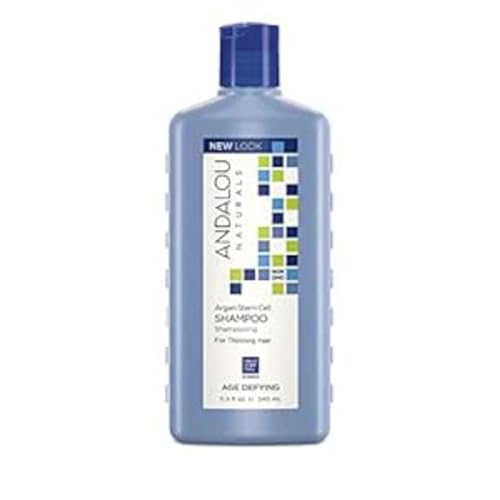
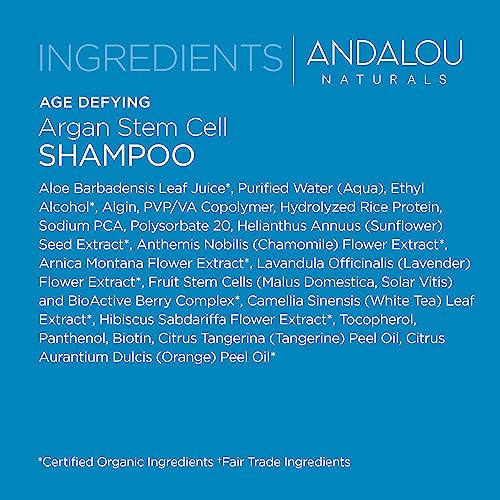
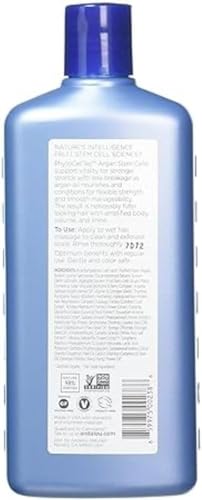
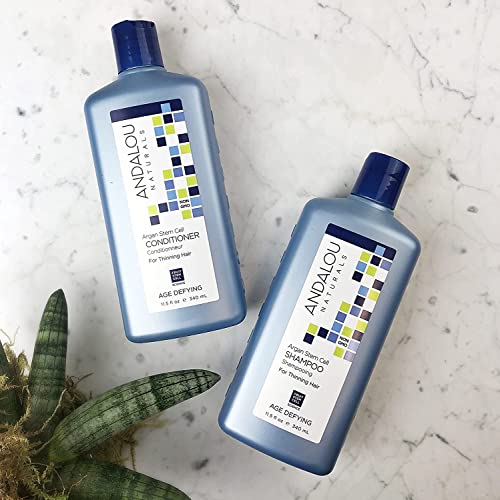
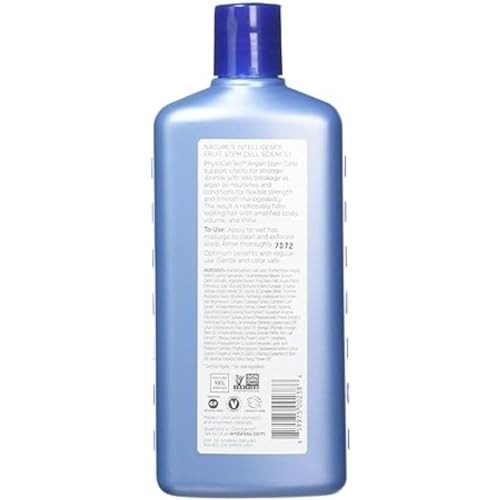
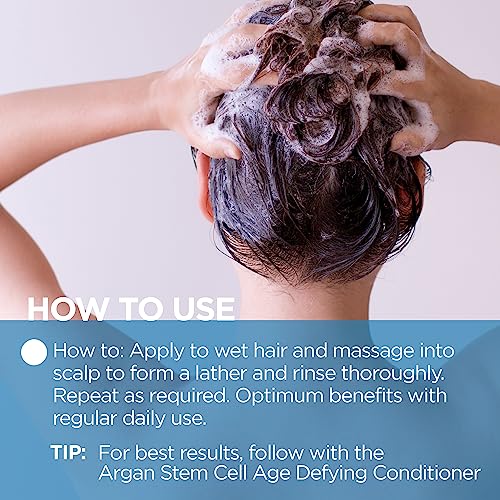
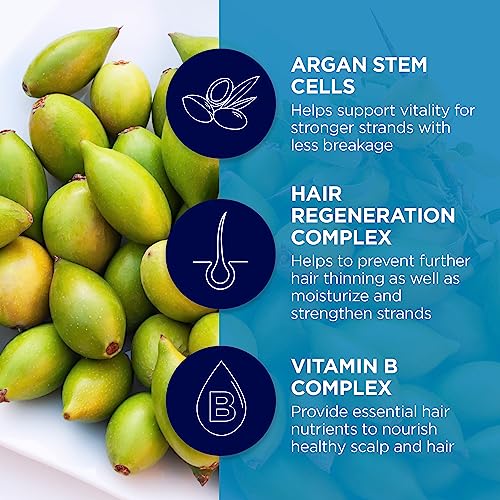
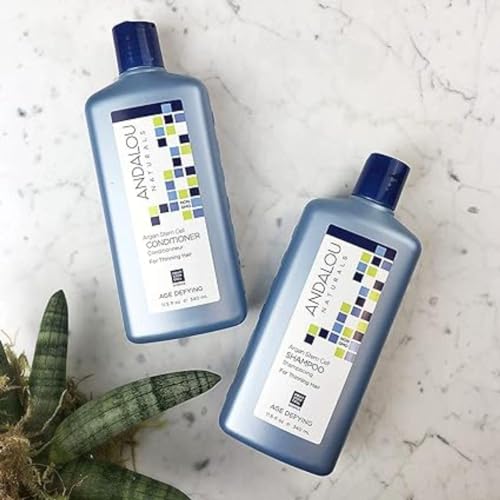
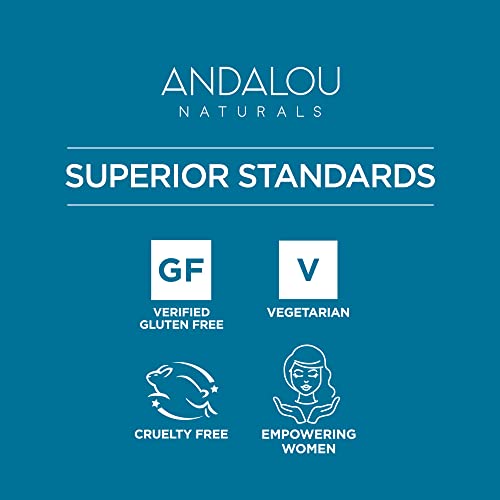
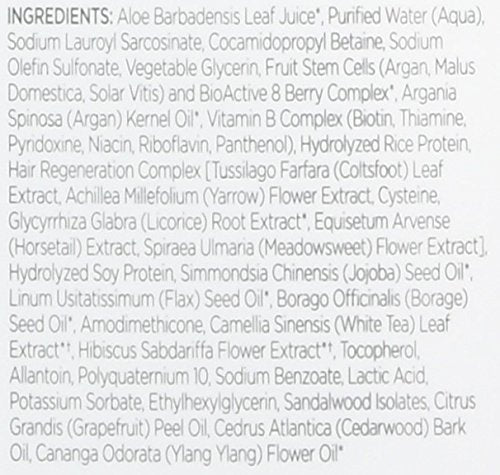
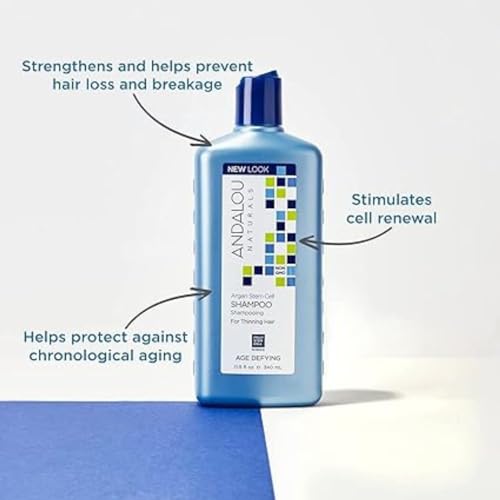
Andalou Naturals Argan Stem Cell Shampoo - Strengthens Thinning Hair, Sulfate-Free - 11.5oz


Lactic Acid
High RiskLactic acid is an alpha hydroxy acid naturally found in milk and fruits. It is commonly used in skincare products for its exfoliating properties, promoting skin renewal and hydration. It can enhance the absorption of other ingredients and is often utilized in formulations aimed at improving skin texture.
Sustai Insights
Lactic acid offers functional benefits such as effective exfoliation and skin hydration. However, it may pose health risks like skin irritation and enhanced absorption of other ingredients, which can lead to increased sensitivity. Regulatory bodies have set high use restrictions due to these concerns. Environmentally, it is not considered bioaccumulative, but care should be taken in disposal to avoid pollution. Overall, the risk level is assessed as high, and usage should be approached with caution, particularly in sensitive populations. Alternatives like glycolic acid may provide similar benefits with varied safety profiles.
Cedrus Atlantica (Atlas Cedar) Bark Oil
High RiskCedrus atlantica (Atlas cedar) bark oil is a volatile essential oil derived from the bark of the Atlas cedar tree. It is commonly used in cosmetic formulations for its aromatic properties and potential skin benefits, including being a natural fragrance component.
Sustai Insights
Cedrus atlantica bark oil offers functional benefits as a natural fragrance and may possess antimicrobial properties. However, it is associated with high allergenic potential and can irritate sensitive skin. Environmental concerns include its pollutant potential if sourced unsustainably. Regulatory bodies note low concerns regarding carcinogenicity and developmental toxicity, yet the overall risk assessment indicates a high risk due to its allergenic properties. Safe usage practices should be followed, and alternatives such as non-allergenic synthetic fragrances may be considered.
Cananga Odorata (Ylang Ylang) Oil
High RiskCananga odorata (ylang ylang) oil is an essential oil derived from the flowers of the ylang ylang tree. It is primarily used in cosmetic and fragrance formulations for its aromatic properties and as a fixative in perfumes.
Sustai Insights
Ylang ylang oil offers functional benefits as a fragrance and fixative, with potential sustainability credentials depending on sourcing practices. However, it has a high allergenic potential, posing risks of skin irritation and sensitization. Regulatory bodies have noted restrictions on its use in certain products. Overall, the ingredient presents a high risk due to health concerns and potential exposure from multiple sources.
Santalum Album (Sandalwood) Extract
High RiskSantalum album (sandalwood) extract is an extract derived from the heartwood of the sandalwood tree, primarily used for its fragrance and potential skin soothing properties in cosmetic formulations. It is often included in products for its aromatic qualities and may also contribute to product preservation.
Sustai Insights
Santalum album extract serves as a fragrance and may provide skin-soothing benefits. However, it has a high allergenic potential and is associated with potential skin irritation. Environmentally, it poses risks as a pollutant, and while it is not currently banned, its regulatory status warrants careful monitoring. Overall, the risk level is high, suggesting cautious use and consideration of alternatives.
Cocamidopropyl Betaine
High RiskCocamidopropyl betaine is a synthetic surfactant derived from coconut oil, commonly used in personal care products for its mild cleansing and foaming properties. It functions as a surfactant, emulsifier, and thickening agent, contributing to the texture and performance of formulations.
Sustai Insights
Cocamidopropyl betaine offers functional benefits as a gentle surfactant, enhancing product foaming and texture. However, it may pose low to moderate allergenic risks and is subject to high use restrictions due to contamination concerns. Regulatory bodies have advised on its safe levels of usage, categorizing its risk level as high overall. Users should practice caution, particularly with sensitive populations, and consider alternatives like naturally derived surfactants for safer formulations.
Camellia Sinensis (Green Tea) Leaf Extract
Medium RiskCamellia sinensis (green tea) leaf extract is derived from the leaves of the Camellia sinensis plant, primarily known for its antioxidant properties. It is commonly used in cosmetic formulations for its potential to soothe the skin and provide protective benefits against environmental stressors.
Sustai Insights
Camellia sinensis leaf extract offers functional benefits, including antioxidant properties that may protect the skin from damage and enhance product efficacy. While generally regarded as safe, it presents moderate allergenic potential and low concerns for carcinogenic or reproductive toxicity. Environmental risks are minimal; however, the sourcing practices should be evaluated for sustainability. Regulatory bodies do not impose significant restrictions, indicating a low-risk profile overall. Safe usage practices are advisable, and alternatives include other botanical extracts with similar benefits.
Achillea Millefolium (Common Yarrow) Extract
Medium RiskAchillea millefolium extract, commonly known as common yarrow extract, is derived from the flowering plant Achillea millefolium. It is used in cosmetic formulations for its various properties, including soothing and anti-inflammatory effects.
Sustai Insights
Achillea millefolium extract offers functional benefits such as skin soothing and potential anti-inflammatory effects, which can enhance product efficacy. It is generally considered low risk for carcinogenicity and developmental toxicity, while showing moderate concerns for allergies. Environmental risks are also low, with no evidence of bioaccumulation. Regulatory bodies have not placed significant restrictions on its use. Safe practices should still be observed due to moderate allergenic potential, and alternatives may be considered for those with sensitivities. Overall, the risk level associated with this ingredient is medium.
Unspecified Extracts
Medium RiskUnspecified extracts refer to a placeholder substance page for skin care formulations, often derived from various natural sources. These extracts are utilized for their potential benefits in maintaining skin health and enhancing product efficacy, but specific functions may vary depending on the source and formulation.
Sustai Insights
Unspecified extracts can provide functional benefits such as enhancing product stability and moisturizing properties. However, they may pose health risks, including low potential for allergies and irritations. Environmental concerns may arise if sourced unsustainably. Regulatory bodies impose minimal restrictions, indicating low risk overall. Safe usage and alternatives are advisable, leading to a medium risk assessment.
Cyamopsis Tetragonoloba (Guar) Gum
Medium RiskCyamopsis tetragonoloba (guar) gum is a resinous substance derived from the seeds of the guar plant. It primarily functions as a thickening and stabilizing agent in various cosmetic and personal care products, enhancing texture and consistency.
Sustai Insights
Guar gum is valued for its thickening capabilities and is derived from a renewable source, contributing to its sustainability credentials. However, it poses moderate allergenic potential and low risks for carcinogenicity and reproductive toxicity. Environmental concerns are minimal, with no significant pollutant or bioaccumulation risks identified. Regulatory status is favorable, with no major restrictions noted. Users should practice caution with sensitive individuals, and alternatives like xanthan gum may serve as effective substitutes. Overall, the risk level associated with guar gum is assessed as medium, warranting careful consideration in product formulation.
Glycyrrhiza Glabra (Licorice) Root Extract
Medium RiskGlycyrrhiza glabra (licorice) root extract is derived from the root of the licorice plant and is commonly used in cosmetic formulations for its soothing properties. It is known for its ability to impart a sweet flavor and is utilized for its skin-brightening and anti-inflammatory effects.
Sustai Insights
Licorice root extract offers functional benefits such as skin soothing and anti-inflammatory properties, making it valuable in cosmetic formulations. It is sourced sustainably; however, it poses low to moderate health risks, including potential allergenic effects and endocrine disruption. Environmental concerns are minimal, with no significant pollutant or bioaccumulation potential. Regulatory bodies restrict its use in certain concentrations, leading to a moderate overall risk assessment. Safe usage practices should be adhered to, and alternatives like chamomile extract may be considered for those seeking lower risk options.
Citrus Grandis (Grapefruit) Peel Oil
Medium RiskCitrus grandis (grapefruit) peel oil is a volatile essential oil extracted from the peel of grapefruit. It is commonly used for its aromatic properties and as a flavoring agent in various products such as cosmetics and food. Its composition includes compounds like limonene and citral.
Sustai Insights
Citrus grandis (grapefruit) peel oil offers functional benefits such as fragrance enhancement and potential skin conditioning properties. However, it is associated with a high risk of allergic reactions and may enhance skin absorption of other substances. Regulatory restrictions apply, particularly regarding its use in products containing certain chemicals. Environmental concerns include its potential as a pollutant. Overall, it poses a medium risk, necessitating caution during use, especially for sensitive populations. Alternatives may include oils from less allergenic sources.
Glycerin
Medium RiskGlycerin (also called glycerol) is a naturally occurring compound commonly used in personal care and cosmetic products. It functions as a humectant, attracting moisture to the skin, and is also utilized as a solvent and emollient to enhance product texture and stability.
Sustai Insights
Glycerin is valued for its effective moisturizing properties and biodegradability, making it a widely accepted ingredient in formulations. It poses low health risks, including low concerns for carcinogenicity and allergies. However, moderate use restrictions exist due to regulatory guidelines. While glycerin does not significantly contribute to environmental pollution, its production process should be ethically sourced. Overall, glycerin holds a medium risk level, emphasizing the importance of safe usage practices and considering sustainable alternatives.
Sodium Benzoate
Medium RiskSodium benzoate is a preservative commonly used in food and cosmetic products to prevent microbial growth and extend shelf life. It is derived from benzoic acid and is effective at low concentrations, often used in acidic environments like beverages and condiments.
Sustai Insights
Sodium benzoate serves effectively as a preservative, contributing to product stability and safety. It is generally recognized as safe with low concerns for carcinogenicity, allergies, and reproductive toxicity, though it faces moderate use restrictions in some regions. Environmental risks include its potential as a pollutant, but it does not bioaccumulate significantly. Regulatory bodies have issued advisories regarding its concentration in products. Overall, the risk level is assessed as medium, with safe usage practices recommended. Alternatives such as potassium sorbate may provide similar benefits with potentially lower restrictions.
Potassium Sorbate
Medium RiskPotassium sorbate is a potassium salt of sorbic acid, primarily used as a preservative in food and cosmetic products. It inhibits the growth of molds, yeast, and some bacteria, extending the shelf life of products. It is commonly found in various formulations due to its effectiveness and low toxicity.
Sustai Insights
Potassium sorbate serves as an effective preservative, preventing microbial growth in food and cosmetic products, which is vital for safety and longevity. Although it has a low risk of carcinogenicity and developmental toxicity, there is a moderate concern regarding allergies and immunotoxicity. Environmentally, it poses minimal risks as it is not significantly bioaccumulative. Regulatory agencies have verified its use, although some products may face restrictions. Overall, it is assessed as a medium risk ingredient, with safe usage practices recommended, and alternatives such as natural preservatives could be considered.
Fruit Stem Cell Complex
Low RiskFruit stem cell complex is derived from fruit stem cells and is commonly used in cosmetic formulations for its potential benefits in skin health. It serves primarily as a bioactive ingredient aimed at promoting skin rejuvenation and cellular repair.
Sustai Insights
Fruit stem cell complex offers functional benefits such as enhancing skin rejuvenation and cellular repair, contributing to healthier skin appearance. It is generally regarded as low risk regarding adverse health effects, with no significant concerns about carcinogenicity, allergens, or reproductive toxicity. Environmentally, it poses minimal risk, lacking bioaccumulative properties or significant pollutants. Regulatory bodies have not placed restrictions on its use. Overall, the ingredient is assessed as low risk, with safe usage practices encouraged; alternatives include other plant-derived extracts that offer similar benefits.
Hydrolyzed Rice Protein
Low RiskHydrolyzed rice protein is a hydrolysate of rice protein, commonly used in cosmetic and personal care products for its film-forming and moisturizing properties. It serves as a conditioning agent that can enhance the texture and feel of formulations.
Sustai Insights
Hydrolyzed rice protein offers functional benefits such as improving moisture retention and hair manageability. It is derived from renewable sources and is biodegradable. Health risks are generally low, with minimal concerns regarding carcinogenicity, allergies, or reproductive toxicity. However, contamination concerns are noted. Environmental risks appear low, with no significant pollutant or bioaccumulative properties. Regulatory status indicates no major restrictions. Overall, the risk level is assessed as low, making it a viable ingredient in formulations with appropriate usage practices.
Sodium Methyl 2 Sulfolaurate
Low RiskSodium methyl 2 sulfolaurate is a surfactant primarily used in personal care and cleaning products. It functions to reduce surface tension, enabling better spreading and cleaning properties. This ingredient is typically derived from renewable resources and is noted for its mild nature in formulations.
Sustai Insights
Sodium methyl 2 sulfolaurate offers functional benefits as an effective surfactant, contributing to the cleaning efficacy of products while being derived from renewable sources, which supports sustainability. Health risks are considered low, with no significant concerns regarding carcinogenicity, allergies, or reproductive toxicity. Environmental risks are also low, as it does not bioaccumulate or contribute significantly to pollution. Regulatory bodies do not impose restrictions on its use. Overall, this ingredient presents a low-risk profile, with no notable adverse effects, making it a viable option in formulations.
Argania Spinosa (Argan) Kernel Oil
Low RiskArgania spinosa (argan) kernel oil is a fixed oil extracted from the kernels of the argan tree, native to Morocco. It is commonly used in cosmetic formulations for its moisturizing properties, serving as an emollient and skin conditioner.
Sustai Insights
Argania spinosa kernel oil offers functional benefits such as effective hydration and nourishment for the skin and hair. It is sustainably sourced and biodegradable, contributing positively to environmental considerations. Health risks are low, with minimal concerns regarding carcinogenicity, allergies, or reproductive toxicity. There are no current regulatory restrictions on its use. Overall, it poses low risk, making it a suitable ingredient in cosmetic products. Safe usage practices should be maintained, and alternatives like jojoba oil may also be considered for similar benefits.
Sodium Lauroyl Methyl Isethionate
Low RiskSodium lauroyl methyl isethionate is a surfactant and cleansing agent commonly used in cosmetic products. It is derived from natural sources and functions primarily to create lather and enhance the cleansing properties of formulations, making it effective in shampoos and body washes.
Sustai Insights
Sodium lauroyl methyl isethionate provides effective cleansing and lathering properties, making it beneficial in personal care products. It is considered biodegradable and has low allergenic potential, posing minimal health risks, including low concerns for carcinogenicity and irritation. Regulatory assessments indicate no significant restrictions, supporting its safe use. Environmental risks are minimal, with no evidence of bioaccumulation or ecotoxicity. Overall, the ingredient is assessed as low risk, with safe usage practices recommended. Alternatives include milder surfactants derived from plant sources.
Cysteine
Low RiskCysteine is an amino acid that plays a crucial role in the synthesis of proteins and is involved in various metabolic processes. It serves as a building block for proteins and is essential for the production of antioxidants, particularly glutathione. Cysteine is commonly found in high-protein foods and is also used as a dietary supplement.
Sustai Insights
Cysteine offers functional benefits as a precursor to antioxidants, aiding in cellular protection and metabolic functions. Its low-risk profile indicates minimal health concerns, including low potential for cancer, allergies, or reproductive toxicity. Environmentally, cysteine does not contribute to significant pollution or bioaccumulation. Regulatory status is favorable, with no substantial restrictions noted. Safe usage practices involve adhering to recommended dietary levels, and while alternatives exist, cysteine's overall risk level is low.
Allantoin
Low RiskAllantoin is a naturally occurring nitrogenous compound found in various plants and animals. It is commonly used in cosmetic formulations for its soothing and moisturizing properties, as well as its ability to promote skin cell turnover and healing.
Sustai Insights
Allantoin offers functional benefits such as skin soothing, hydration, and promoting cell regeneration. It is generally recognized as safe, with low concerns regarding carcinogenicity, allergies, and reproductive toxicity. Environmentally, it poses minimal risks, being biodegradable and sustainably sourced. Regulatory bodies do not impose significant restrictions on its use. Overall, the risk level associated with allantoin is low, making it a favorable ingredient in personal care products.
Sodium Pca
Low RiskSodium PCA is a derivative of naturally occurring amino acids and is primarily used in cosmetics for its moisturizing properties. It acts as a humectant, attracting and retaining moisture in the skin, thereby enhancing hydration and improving skin texture.
Sustai Insights
Sodium PCA offers functional benefits as an effective humectant, enhancing skin moisture levels. It is derived from natural sources, supporting sustainable practices. Health risks are low, with minimal concerns regarding carcinogenicity, allergies, or reproductive toxicity. Environmental risks are also low, as it is not known to be bioaccumulative or a significant pollutant. Regulatory bodies have not placed significant restrictions on its use. Overall, it presents a low risk profile, making it a suitable ingredient in cosmetic formulations. Alternatives may include other humectants like glycerin or hyaluronic acid.
Spiraea Ulmaria (Meadowsweet) Flower Extract
Low RiskSpiraea ulmaria (meadowsweet) flower extract is derived from the flowers of the Spiraea ulmaria plant. It is commonly used in cosmetic formulations for its soothing properties and is known for its role in skin care as an anti-inflammatory and astringent agent.
Sustai Insights
Meadowsweet flower extract offers functional benefits such as anti-inflammatory and astringent properties, making it useful in soothing skin formulations. It is sustainably sourced and generally recognized as safe, with low concerns regarding carcinogenicity, allergies, and reproductive toxicity. Environmental risks are minimal, as it does not contribute significantly to pollution or bioaccumulation. Regulatory bodies do not impose restrictions on its use. Overall, the ingredient presents a low risk profile, making it a viable choice in cosmetic products.
Tussilago Farfara (Coltsfoot) Leaf Extract
Low RiskTussilago farfara (coltsfoot) leaf extract is derived from the leaves of the coltsfoot plant, known for its traditional use in herbal medicine. It is often included in cosmetic formulations for its soothing and anti-inflammatory properties.
Sustai Insights
Coltsfoot leaf extract offers functional benefits, primarily as a soothing agent in skincare. It is considered to have low health risks, with no significant concerns regarding carcinogenicity, irritations, or allergies. Environmentally, it poses minimal risks, showing low pollutant potential and no bioaccumulation. Regulatory assessments indicate no restrictions on use. Overall, the risk level is low, and while alternatives exist, coltsfoot leaf extract remains a viable option in cosmetic applications.
Borago Officinalis (Borage) Seed Oil
Low RiskBorago officinalis (borage) seed oil is an oil derived from the seeds of the borage plant, known for its high content of gamma-linolenic acid (GLA). It is commonly used in cosmetic formulations for its moisturizing properties and potential to improve skin barrier function.
Sustai Insights
Borage seed oil is valued for its moisturizing benefits and is considered sustainably sourced. It has a low risk of causing health issues, including carcinogenicity, allergies, or reproductive toxicity. Environmental risks appear minimal, with no significant concerns related to bioaccumulation or pollution. Regulatory bodies do not impose significant restrictions on its use. Overall, the ingredient is assessed as low risk, making it a suitable option in cosmetic products.
Disodium 2 Sulfolaurate
Low RiskDisodium 2 sulfolaurate is a surfactant and emulsifying agent commonly used in personal care products. It functions primarily to help cleanse, foaming, and stabilize formulations, enhancing the overall texture and performance of the product.
Sustai Insights
Disodium 2 sulfolaurate offers functional benefits as an effective surfactant, improving product stability and user experience. It is considered to have low health risks, with no significant concerns regarding carcinogenicity, allergenic potential, or reproductive toxicity. Environmental risks are minimal, with no evidence of bioaccumulation or significant pollution. Regulatory assessments indicate no current restrictions, affirming its safe use. Overall, the risk level is low, making it a suitable ingredient in formulated products.
Equisetum Arvense (Horsetail) Extract
Low RiskEquisetum arvense extract is derived from the horsetail plant, known for its high silica content. It is commonly used in cosmetic formulations for its potential benefits in promoting healthy skin and hair, as well as its role as a natural preservative due to its antioxidant properties.
Sustai Insights
Equisetum arvense extract offers functional benefits including enhancing skin and hair health through its silica content and antioxidant properties. It is sustainably sourced and biodegradable. Health risks are minimal, with low concerns for carcinogenicity, allergies, and reproductive toxicity. Environmental risks are also low, with no significant pollutant or bioaccumulative effects noted. Regulatory bodies do not list this ingredient as restricted. Overall, the risk level is assessed as low, making it a safe option in cosmetic products.
Hibiscus Sabdariffa (Roselle) Flower Extract
Low RiskHibiscus sabdariffa (roselle) flower extract is derived from the calyx of the hibiscus plant, used primarily for its potential antioxidant properties and as a natural colorant in various cosmetic and food products.
Sustai Insights
Hibiscus sabdariffa flower extract offers functional benefits such as antioxidant properties and natural coloring, while being sustainably sourced with low environmental impact. Health risks, including irritant potential, are minimal, and it is not classified as a carcinogen or allergen. Regulatory status is favorable, with no current restrictions. Overall, the risk level is assessed as low, making it a safe choice in formulations.
Vitamin B Complex
Low RiskVitamin B complex refers to a group of water-soluble vitamins that play essential roles in cell metabolism. These vitamins include B1 (thiamine), B2 (riboflavin), B3 (niacin), B5 (pantothenic acid), B6 (pyridoxine), B7 (biotin), B9 (folate), and B12 (cobalamin). They are commonly included in dietary supplements and fortified foods to support various bodily functions including energy production and red blood cell formation.
Sustai Insights
Vitamin B complex serves critical roles in energy metabolism and neurological function, demonstrating no significant health risks such as carcinogenicity or allergies. It is generally safe with low environmental risks, being non-pollutant and biodegradable. Regulatory bodies have not flagged any restrictions. Safe usage involves adhering to recommended dietary allowances; however, excessive intake may lead to adverse effects. Overall, the ingredient's risk level is assessed as low, with no substantial health or environmental concerns noted.
Linum Usitatissimum (Flax) Oil
Low RiskLinum usitatissimum (flax) oil is derived from the seeds of the flax plant and is primarily used as an emollient and skin conditioning agent in cosmetic formulations. It is known for its high content of omega-3 fatty acids and antioxidants, contributing to its role in moisturizing products.
Sustai Insights
Linum usitatissimum (flax) oil offers functional benefits such as skin nourishment and hydration due to its fatty acid profile, while being biodegradable and derived from a renewable source, enhancing its sustainability credentials. Health risks are low, with minimal concerns regarding carcinogenicity, allergies, or reproductive toxicity. Environmental risks are also low, as it does not contribute significantly to pollution or bioaccumulation. Regulatory assessments indicate no current restrictions. Overall, the ingredient presents a low risk, suitable for various formulations with safe usage practices.
Water
Low RiskWater is a clear, colorless liquid essential for various biological processes. It serves as a solvent in formulations, facilitating the dissolution of other ingredients and enhancing product texture and application. Additionally, water plays a crucial role in hydration and is a key component in many cosmetic and personal care products.
Sustai Insights
Water is an effective solvent and hydrator, contributing to the texture and efficacy of formulations. It is biodegradable and generally regarded as safe, with low concerns regarding carcinogenicity, allergies, and reproductive toxicity. However, excessive water usage can lead to environmental concerns, particularly regarding resource depletion. Regulatory bodies do not impose restrictions on water use in cosmetics. Overall, the risks associated with water are low, making it a safe and essential ingredient.
Tocopherol
Low RiskTocopherols are a class of naturally occurring compounds, primarily known for their role as antioxidants. They are commonly used in cosmetic and skincare products to help stabilize formulations and protect ingredients from oxidative damage.
Sustai Insights
Tocopherols provide functional benefits such as antioxidant protection and skin conditioning. They are generally recognized as safe, with low concerns regarding carcinogenicity, allergies, and reproductive toxicity. However, enhanced skin absorption and potential endocrine disruption are noted. Regulatory bodies have not imposed significant restrictions on tocopherols, categorizing the overall risk as low. Safe usage practices should be observed, and while alternatives exist, tocopherols remain a viable option in formulations.
Simmondsia Chinensis (Jojoba) Seed Oil
Low RiskSimmondsia chinensis (jojoba) seed oil is extracted from the seeds of the jojoba plant. It is commonly used in cosmetics for its moisturizing properties and ability to mimic human sebum, making it beneficial for skin and hair care formulations.
Sustai Insights
Jojoba seed oil offers functional benefits such as effective moisturization and emollience, contributing to skin hydration and smoothness. It is sustainably sourced and biodegradable. Health risks are low, with minimal concerns regarding carcinogenicity, allergies, and reproductive toxicity. Environmental risks are also low, as it does not significantly contribute to pollution or bioaccumulation. Currently, there are no regulatory restrictions on its use. Overall, the risk level is low, and it is considered a safe ingredient with no significant adverse effects.
Aloe Barbadensis (Aloe Vera) Leaf Juice
Low RiskAloe barbadensis (aloe vera) leaf juice is derived from the succulent aloe vera plant, known for its hydrating and soothing properties. It is commonly used in cosmetic formulations for its moisturizing effects and is often included in products aimed at skin care and healing.
Sustai Insights
Aloe vera leaf juice offers functional benefits as a moisturizer and skin soothing agent, while being sustainably sourced and biodegradable. Health risks are low, with minimal concerns regarding carcinogenicity, allergies, and reproductive toxicity. Environmental impact is also low, with no significant pollutants identified. Regulatory agencies impose few restrictions. Overall, the ingredient poses a low risk, making it a favorable choice in cosmetic formulations.
Lactic Acid
High RiskLactic acid is an alpha hydroxy acid naturally found in milk and fruits. It is commonly used in skincare products for its exfoliating properties, promoting skin renewal and hydration. It can enhance the absorption of other ingredients and is often utilized in formulations aimed at improving skin texture.
Sustai Insights
Lactic acid offers functional benefits such as effective exfoliation and skin hydration. However, it may pose health risks like skin irritation and enhanced absorption of other ingredients, which can lead to increased sensitivity. Regulatory bodies have set high use restrictions due to these concerns. Environmentally, it is not considered bioaccumulative, but care should be taken in disposal to avoid pollution. Overall, the risk level is assessed as high, and usage should be approached with caution, particularly in sensitive populations. Alternatives like glycolic acid may provide similar benefits with varied safety profiles.
Fruit Stem Cell Complex
Low RiskFruit stem cell complex is derived from fruit stem cells and is commonly used in cosmetic formulations for its potential benefits in skin health. It serves primarily as a bioactive ingredient aimed at promoting skin rejuvenation and cellular repair.
Sustai Insights
Fruit stem cell complex offers functional benefits such as enhancing skin rejuvenation and cellular repair, contributing to healthier skin appearance. It is generally regarded as low risk regarding adverse health effects, with no significant concerns about carcinogenicity, allergens, or reproductive toxicity. Environmentally, it poses minimal risk, lacking bioaccumulative properties or significant pollutants. Regulatory bodies have not placed restrictions on its use. Overall, the ingredient is assessed as low risk, with safe usage practices encouraged; alternatives include other plant-derived extracts that offer similar benefits.
Hydrolyzed Rice Protein
Low RiskHydrolyzed rice protein is a hydrolysate of rice protein, commonly used in cosmetic and personal care products for its film-forming and moisturizing properties. It serves as a conditioning agent that can enhance the texture and feel of formulations.
Sustai Insights
Hydrolyzed rice protein offers functional benefits such as improving moisture retention and hair manageability. It is derived from renewable sources and is biodegradable. Health risks are generally low, with minimal concerns regarding carcinogenicity, allergies, or reproductive toxicity. However, contamination concerns are noted. Environmental risks appear low, with no significant pollutant or bioaccumulative properties. Regulatory status indicates no major restrictions. Overall, the risk level is assessed as low, making it a viable ingredient in formulations with appropriate usage practices.
Sodium Methyl 2 Sulfolaurate
Low RiskSodium methyl 2 sulfolaurate is a surfactant primarily used in personal care and cleaning products. It functions to reduce surface tension, enabling better spreading and cleaning properties. This ingredient is typically derived from renewable resources and is noted for its mild nature in formulations.
Sustai Insights
Sodium methyl 2 sulfolaurate offers functional benefits as an effective surfactant, contributing to the cleaning efficacy of products while being derived from renewable sources, which supports sustainability. Health risks are considered low, with no significant concerns regarding carcinogenicity, allergies, or reproductive toxicity. Environmental risks are also low, as it does not bioaccumulate or contribute significantly to pollution. Regulatory bodies do not impose restrictions on its use. Overall, this ingredient presents a low-risk profile, with no notable adverse effects, making it a viable option in formulations.
Cedrus Atlantica (Atlas Cedar) Bark Oil
High RiskCedrus atlantica (Atlas cedar) bark oil is a volatile essential oil derived from the bark of the Atlas cedar tree. It is commonly used in cosmetic formulations for its aromatic properties and potential skin benefits, including being a natural fragrance component.
Sustai Insights
Cedrus atlantica bark oil offers functional benefits as a natural fragrance and may possess antimicrobial properties. However, it is associated with high allergenic potential and can irritate sensitive skin. Environmental concerns include its pollutant potential if sourced unsustainably. Regulatory bodies note low concerns regarding carcinogenicity and developmental toxicity, yet the overall risk assessment indicates a high risk due to its allergenic properties. Safe usage practices should be followed, and alternatives such as non-allergenic synthetic fragrances may be considered.
Cananga Odorata (Ylang Ylang) Oil
High RiskCananga odorata (ylang ylang) oil is an essential oil derived from the flowers of the ylang ylang tree. It is primarily used in cosmetic and fragrance formulations for its aromatic properties and as a fixative in perfumes.
Sustai Insights
Ylang ylang oil offers functional benefits as a fragrance and fixative, with potential sustainability credentials depending on sourcing practices. However, it has a high allergenic potential, posing risks of skin irritation and sensitization. Regulatory bodies have noted restrictions on its use in certain products. Overall, the ingredient presents a high risk due to health concerns and potential exposure from multiple sources.
Argania Spinosa (Argan) Kernel Oil
Low RiskArgania spinosa (argan) kernel oil is a fixed oil extracted from the kernels of the argan tree, native to Morocco. It is commonly used in cosmetic formulations for its moisturizing properties, serving as an emollient and skin conditioner.
Sustai Insights
Argania spinosa kernel oil offers functional benefits such as effective hydration and nourishment for the skin and hair. It is sustainably sourced and biodegradable, contributing positively to environmental considerations. Health risks are low, with minimal concerns regarding carcinogenicity, allergies, or reproductive toxicity. There are no current regulatory restrictions on its use. Overall, it poses low risk, making it a suitable ingredient in cosmetic products. Safe usage practices should be maintained, and alternatives like jojoba oil may also be considered for similar benefits.
Sodium Lauroyl Methyl Isethionate
Low RiskSodium lauroyl methyl isethionate is a surfactant and cleansing agent commonly used in cosmetic products. It is derived from natural sources and functions primarily to create lather and enhance the cleansing properties of formulations, making it effective in shampoos and body washes.
Sustai Insights
Sodium lauroyl methyl isethionate provides effective cleansing and lathering properties, making it beneficial in personal care products. It is considered biodegradable and has low allergenic potential, posing minimal health risks, including low concerns for carcinogenicity and irritation. Regulatory assessments indicate no significant restrictions, supporting its safe use. Environmental risks are minimal, with no evidence of bioaccumulation or ecotoxicity. Overall, the ingredient is assessed as low risk, with safe usage practices recommended. Alternatives include milder surfactants derived from plant sources.
Camellia Sinensis (Green Tea) Leaf Extract
Medium RiskCamellia sinensis (green tea) leaf extract is derived from the leaves of the Camellia sinensis plant, primarily known for its antioxidant properties. It is commonly used in cosmetic formulations for its potential to soothe the skin and provide protective benefits against environmental stressors.
Sustai Insights
Camellia sinensis leaf extract offers functional benefits, including antioxidant properties that may protect the skin from damage and enhance product efficacy. While generally regarded as safe, it presents moderate allergenic potential and low concerns for carcinogenic or reproductive toxicity. Environmental risks are minimal; however, the sourcing practices should be evaluated for sustainability. Regulatory bodies do not impose significant restrictions, indicating a low-risk profile overall. Safe usage practices are advisable, and alternatives include other botanical extracts with similar benefits.
Cysteine
Low RiskCysteine is an amino acid that plays a crucial role in the synthesis of proteins and is involved in various metabolic processes. It serves as a building block for proteins and is essential for the production of antioxidants, particularly glutathione. Cysteine is commonly found in high-protein foods and is also used as a dietary supplement.
Sustai Insights
Cysteine offers functional benefits as a precursor to antioxidants, aiding in cellular protection and metabolic functions. Its low-risk profile indicates minimal health concerns, including low potential for cancer, allergies, or reproductive toxicity. Environmentally, cysteine does not contribute to significant pollution or bioaccumulation. Regulatory status is favorable, with no substantial restrictions noted. Safe usage practices involve adhering to recommended dietary levels, and while alternatives exist, cysteine's overall risk level is low.
Achillea Millefolium (Common Yarrow) Extract
Medium RiskAchillea millefolium extract, commonly known as common yarrow extract, is derived from the flowering plant Achillea millefolium. It is used in cosmetic formulations for its various properties, including soothing and anti-inflammatory effects.
Sustai Insights
Achillea millefolium extract offers functional benefits such as skin soothing and potential anti-inflammatory effects, which can enhance product efficacy. It is generally considered low risk for carcinogenicity and developmental toxicity, while showing moderate concerns for allergies. Environmental risks are also low, with no evidence of bioaccumulation. Regulatory bodies have not placed significant restrictions on its use. Safe practices should still be observed due to moderate allergenic potential, and alternatives may be considered for those with sensitivities. Overall, the risk level associated with this ingredient is medium.
Allantoin
Low RiskAllantoin is a naturally occurring nitrogenous compound found in various plants and animals. It is commonly used in cosmetic formulations for its soothing and moisturizing properties, as well as its ability to promote skin cell turnover and healing.
Sustai Insights
Allantoin offers functional benefits such as skin soothing, hydration, and promoting cell regeneration. It is generally recognized as safe, with low concerns regarding carcinogenicity, allergies, and reproductive toxicity. Environmentally, it poses minimal risks, being biodegradable and sustainably sourced. Regulatory bodies do not impose significant restrictions on its use. Overall, the risk level associated with allantoin is low, making it a favorable ingredient in personal care products.
Unspecified Extracts
Medium RiskUnspecified extracts refer to a placeholder substance page for skin care formulations, often derived from various natural sources. These extracts are utilized for their potential benefits in maintaining skin health and enhancing product efficacy, but specific functions may vary depending on the source and formulation.
Sustai Insights
Unspecified extracts can provide functional benefits such as enhancing product stability and moisturizing properties. However, they may pose health risks, including low potential for allergies and irritations. Environmental concerns may arise if sourced unsustainably. Regulatory bodies impose minimal restrictions, indicating low risk overall. Safe usage and alternatives are advisable, leading to a medium risk assessment.
Sodium Pca
Low RiskSodium PCA is a derivative of naturally occurring amino acids and is primarily used in cosmetics for its moisturizing properties. It acts as a humectant, attracting and retaining moisture in the skin, thereby enhancing hydration and improving skin texture.
Sustai Insights
Sodium PCA offers functional benefits as an effective humectant, enhancing skin moisture levels. It is derived from natural sources, supporting sustainable practices. Health risks are low, with minimal concerns regarding carcinogenicity, allergies, or reproductive toxicity. Environmental risks are also low, as it is not known to be bioaccumulative or a significant pollutant. Regulatory bodies have not placed significant restrictions on its use. Overall, it presents a low risk profile, making it a suitable ingredient in cosmetic formulations. Alternatives may include other humectants like glycerin or hyaluronic acid.
Spiraea Ulmaria (Meadowsweet) Flower Extract
Low RiskSpiraea ulmaria (meadowsweet) flower extract is derived from the flowers of the Spiraea ulmaria plant. It is commonly used in cosmetic formulations for its soothing properties and is known for its role in skin care as an anti-inflammatory and astringent agent.
Sustai Insights
Meadowsweet flower extract offers functional benefits such as anti-inflammatory and astringent properties, making it useful in soothing skin formulations. It is sustainably sourced and generally recognized as safe, with low concerns regarding carcinogenicity, allergies, and reproductive toxicity. Environmental risks are minimal, as it does not contribute significantly to pollution or bioaccumulation. Regulatory bodies do not impose restrictions on its use. Overall, the ingredient presents a low risk profile, making it a viable choice in cosmetic products.
Cyamopsis Tetragonoloba (Guar) Gum
Medium RiskCyamopsis tetragonoloba (guar) gum is a resinous substance derived from the seeds of the guar plant. It primarily functions as a thickening and stabilizing agent in various cosmetic and personal care products, enhancing texture and consistency.
Sustai Insights
Guar gum is valued for its thickening capabilities and is derived from a renewable source, contributing to its sustainability credentials. However, it poses moderate allergenic potential and low risks for carcinogenicity and reproductive toxicity. Environmental concerns are minimal, with no significant pollutant or bioaccumulation risks identified. Regulatory status is favorable, with no major restrictions noted. Users should practice caution with sensitive individuals, and alternatives like xanthan gum may serve as effective substitutes. Overall, the risk level associated with guar gum is assessed as medium, warranting careful consideration in product formulation.
Santalum Album (Sandalwood) Extract
High RiskSantalum album (sandalwood) extract is an extract derived from the heartwood of the sandalwood tree, primarily used for its fragrance and potential skin soothing properties in cosmetic formulations. It is often included in products for its aromatic qualities and may also contribute to product preservation.
Sustai Insights
Santalum album extract serves as a fragrance and may provide skin-soothing benefits. However, it has a high allergenic potential and is associated with potential skin irritation. Environmentally, it poses risks as a pollutant, and while it is not currently banned, its regulatory status warrants careful monitoring. Overall, the risk level is high, suggesting cautious use and consideration of alternatives.
Tussilago Farfara (Coltsfoot) Leaf Extract
Low RiskTussilago farfara (coltsfoot) leaf extract is derived from the leaves of the coltsfoot plant, known for its traditional use in herbal medicine. It is often included in cosmetic formulations for its soothing and anti-inflammatory properties.
Sustai Insights
Coltsfoot leaf extract offers functional benefits, primarily as a soothing agent in skincare. It is considered to have low health risks, with no significant concerns regarding carcinogenicity, irritations, or allergies. Environmentally, it poses minimal risks, showing low pollutant potential and no bioaccumulation. Regulatory assessments indicate no restrictions on use. Overall, the risk level is low, and while alternatives exist, coltsfoot leaf extract remains a viable option in cosmetic applications.
Borago Officinalis (Borage) Seed Oil
Low RiskBorago officinalis (borage) seed oil is an oil derived from the seeds of the borage plant, known for its high content of gamma-linolenic acid (GLA). It is commonly used in cosmetic formulations for its moisturizing properties and potential to improve skin barrier function.
Sustai Insights
Borage seed oil is valued for its moisturizing benefits and is considered sustainably sourced. It has a low risk of causing health issues, including carcinogenicity, allergies, or reproductive toxicity. Environmental risks appear minimal, with no significant concerns related to bioaccumulation or pollution. Regulatory bodies do not impose significant restrictions on its use. Overall, the ingredient is assessed as low risk, making it a suitable option in cosmetic products.
Glycyrrhiza Glabra (Licorice) Root Extract
Medium RiskGlycyrrhiza glabra (licorice) root extract is derived from the root of the licorice plant and is commonly used in cosmetic formulations for its soothing properties. It is known for its ability to impart a sweet flavor and is utilized for its skin-brightening and anti-inflammatory effects.
Sustai Insights
Licorice root extract offers functional benefits such as skin soothing and anti-inflammatory properties, making it valuable in cosmetic formulations. It is sourced sustainably; however, it poses low to moderate health risks, including potential allergenic effects and endocrine disruption. Environmental concerns are minimal, with no significant pollutant or bioaccumulation potential. Regulatory bodies restrict its use in certain concentrations, leading to a moderate overall risk assessment. Safe usage practices should be adhered to, and alternatives like chamomile extract may be considered for those seeking lower risk options.
Disodium 2 Sulfolaurate
Low RiskDisodium 2 sulfolaurate is a surfactant and emulsifying agent commonly used in personal care products. It functions primarily to help cleanse, foaming, and stabilize formulations, enhancing the overall texture and performance of the product.
Sustai Insights
Disodium 2 sulfolaurate offers functional benefits as an effective surfactant, improving product stability and user experience. It is considered to have low health risks, with no significant concerns regarding carcinogenicity, allergenic potential, or reproductive toxicity. Environmental risks are minimal, with no evidence of bioaccumulation or significant pollution. Regulatory assessments indicate no current restrictions, affirming its safe use. Overall, the risk level is low, making it a suitable ingredient in formulated products.
Equisetum Arvense (Horsetail) Extract
Low RiskEquisetum arvense extract is derived from the horsetail plant, known for its high silica content. It is commonly used in cosmetic formulations for its potential benefits in promoting healthy skin and hair, as well as its role as a natural preservative due to its antioxidant properties.
Sustai Insights
Equisetum arvense extract offers functional benefits including enhancing skin and hair health through its silica content and antioxidant properties. It is sustainably sourced and biodegradable. Health risks are minimal, with low concerns for carcinogenicity, allergies, and reproductive toxicity. Environmental risks are also low, with no significant pollutant or bioaccumulative effects noted. Regulatory bodies do not list this ingredient as restricted. Overall, the risk level is assessed as low, making it a safe option in cosmetic products.
Hibiscus Sabdariffa (Roselle) Flower Extract
Low RiskHibiscus sabdariffa (roselle) flower extract is derived from the calyx of the hibiscus plant, used primarily for its potential antioxidant properties and as a natural colorant in various cosmetic and food products.
Sustai Insights
Hibiscus sabdariffa flower extract offers functional benefits such as antioxidant properties and natural coloring, while being sustainably sourced with low environmental impact. Health risks, including irritant potential, are minimal, and it is not classified as a carcinogen or allergen. Regulatory status is favorable, with no current restrictions. Overall, the risk level is assessed as low, making it a safe choice in formulations.
Vitamin B Complex
Low RiskVitamin B complex refers to a group of water-soluble vitamins that play essential roles in cell metabolism. These vitamins include B1 (thiamine), B2 (riboflavin), B3 (niacin), B5 (pantothenic acid), B6 (pyridoxine), B7 (biotin), B9 (folate), and B12 (cobalamin). They are commonly included in dietary supplements and fortified foods to support various bodily functions including energy production and red blood cell formation.
Sustai Insights
Vitamin B complex serves critical roles in energy metabolism and neurological function, demonstrating no significant health risks such as carcinogenicity or allergies. It is generally safe with low environmental risks, being non-pollutant and biodegradable. Regulatory bodies have not flagged any restrictions. Safe usage involves adhering to recommended dietary allowances; however, excessive intake may lead to adverse effects. Overall, the ingredient's risk level is assessed as low, with no substantial health or environmental concerns noted.
Citrus Grandis (Grapefruit) Peel Oil
Medium RiskCitrus grandis (grapefruit) peel oil is a volatile essential oil extracted from the peel of grapefruit. It is commonly used for its aromatic properties and as a flavoring agent in various products such as cosmetics and food. Its composition includes compounds like limonene and citral.
Sustai Insights
Citrus grandis (grapefruit) peel oil offers functional benefits such as fragrance enhancement and potential skin conditioning properties. However, it is associated with a high risk of allergic reactions and may enhance skin absorption of other substances. Regulatory restrictions apply, particularly regarding its use in products containing certain chemicals. Environmental concerns include its potential as a pollutant. Overall, it poses a medium risk, necessitating caution during use, especially for sensitive populations. Alternatives may include oils from less allergenic sources.
Linum Usitatissimum (Flax) Oil
Low RiskLinum usitatissimum (flax) oil is derived from the seeds of the flax plant and is primarily used as an emollient and skin conditioning agent in cosmetic formulations. It is known for its high content of omega-3 fatty acids and antioxidants, contributing to its role in moisturizing products.
Sustai Insights
Linum usitatissimum (flax) oil offers functional benefits such as skin nourishment and hydration due to its fatty acid profile, while being biodegradable and derived from a renewable source, enhancing its sustainability credentials. Health risks are low, with minimal concerns regarding carcinogenicity, allergies, or reproductive toxicity. Environmental risks are also low, as it does not contribute significantly to pollution or bioaccumulation. Regulatory assessments indicate no current restrictions. Overall, the ingredient presents a low risk, suitable for various formulations with safe usage practices.
Water
Low RiskWater is a clear, colorless liquid essential for various biological processes. It serves as a solvent in formulations, facilitating the dissolution of other ingredients and enhancing product texture and application. Additionally, water plays a crucial role in hydration and is a key component in many cosmetic and personal care products.
Sustai Insights
Water is an effective solvent and hydrator, contributing to the texture and efficacy of formulations. It is biodegradable and generally regarded as safe, with low concerns regarding carcinogenicity, allergies, and reproductive toxicity. However, excessive water usage can lead to environmental concerns, particularly regarding resource depletion. Regulatory bodies do not impose restrictions on water use in cosmetics. Overall, the risks associated with water are low, making it a safe and essential ingredient.
Glycerin
Medium RiskGlycerin (also called glycerol) is a naturally occurring compound commonly used in personal care and cosmetic products. It functions as a humectant, attracting moisture to the skin, and is also utilized as a solvent and emollient to enhance product texture and stability.
Sustai Insights
Glycerin is valued for its effective moisturizing properties and biodegradability, making it a widely accepted ingredient in formulations. It poses low health risks, including low concerns for carcinogenicity and allergies. However, moderate use restrictions exist due to regulatory guidelines. While glycerin does not significantly contribute to environmental pollution, its production process should be ethically sourced. Overall, glycerin holds a medium risk level, emphasizing the importance of safe usage practices and considering sustainable alternatives.
Tocopherol
Low RiskTocopherols are a class of naturally occurring compounds, primarily known for their role as antioxidants. They are commonly used in cosmetic and skincare products to help stabilize formulations and protect ingredients from oxidative damage.
Sustai Insights
Tocopherols provide functional benefits such as antioxidant protection and skin conditioning. They are generally recognized as safe, with low concerns regarding carcinogenicity, allergies, and reproductive toxicity. However, enhanced skin absorption and potential endocrine disruption are noted. Regulatory bodies have not imposed significant restrictions on tocopherols, categorizing the overall risk as low. Safe usage practices should be observed, and while alternatives exist, tocopherols remain a viable option in formulations.
Sodium Benzoate
Medium RiskSodium benzoate is a preservative commonly used in food and cosmetic products to prevent microbial growth and extend shelf life. It is derived from benzoic acid and is effective at low concentrations, often used in acidic environments like beverages and condiments.
Sustai Insights
Sodium benzoate serves effectively as a preservative, contributing to product stability and safety. It is generally recognized as safe with low concerns for carcinogenicity, allergies, and reproductive toxicity, though it faces moderate use restrictions in some regions. Environmental risks include its potential as a pollutant, but it does not bioaccumulate significantly. Regulatory bodies have issued advisories regarding its concentration in products. Overall, the risk level is assessed as medium, with safe usage practices recommended. Alternatives such as potassium sorbate may provide similar benefits with potentially lower restrictions.
Potassium Sorbate
Medium RiskPotassium sorbate is a potassium salt of sorbic acid, primarily used as a preservative in food and cosmetic products. It inhibits the growth of molds, yeast, and some bacteria, extending the shelf life of products. It is commonly found in various formulations due to its effectiveness and low toxicity.
Sustai Insights
Potassium sorbate serves as an effective preservative, preventing microbial growth in food and cosmetic products, which is vital for safety and longevity. Although it has a low risk of carcinogenicity and developmental toxicity, there is a moderate concern regarding allergies and immunotoxicity. Environmentally, it poses minimal risks as it is not significantly bioaccumulative. Regulatory agencies have verified its use, although some products may face restrictions. Overall, it is assessed as a medium risk ingredient, with safe usage practices recommended, and alternatives such as natural preservatives could be considered.
Cocamidopropyl Betaine
High RiskCocamidopropyl betaine is a synthetic surfactant derived from coconut oil, commonly used in personal care products for its mild cleansing and foaming properties. It functions as a surfactant, emulsifier, and thickening agent, contributing to the texture and performance of formulations.
Sustai Insights
Cocamidopropyl betaine offers functional benefits as a gentle surfactant, enhancing product foaming and texture. However, it may pose low to moderate allergenic risks and is subject to high use restrictions due to contamination concerns. Regulatory bodies have advised on its safe levels of usage, categorizing its risk level as high overall. Users should practice caution, particularly with sensitive populations, and consider alternatives like naturally derived surfactants for safer formulations.
Simmondsia Chinensis (Jojoba) Seed Oil
Low RiskSimmondsia chinensis (jojoba) seed oil is extracted from the seeds of the jojoba plant. It is commonly used in cosmetics for its moisturizing properties and ability to mimic human sebum, making it beneficial for skin and hair care formulations.
Sustai Insights
Jojoba seed oil offers functional benefits such as effective moisturization and emollience, contributing to skin hydration and smoothness. It is sustainably sourced and biodegradable. Health risks are low, with minimal concerns regarding carcinogenicity, allergies, and reproductive toxicity. Environmental risks are also low, as it does not significantly contribute to pollution or bioaccumulation. Currently, there are no regulatory restrictions on its use. Overall, the risk level is low, and it is considered a safe ingredient with no significant adverse effects.
Aloe Barbadensis (Aloe Vera) Leaf Juice
Low RiskAloe barbadensis (aloe vera) leaf juice is derived from the succulent aloe vera plant, known for its hydrating and soothing properties. It is commonly used in cosmetic formulations for its moisturizing effects and is often included in products aimed at skin care and healing.
Sustai Insights
Aloe vera leaf juice offers functional benefits as a moisturizer and skin soothing agent, while being sustainably sourced and biodegradable. Health risks are low, with minimal concerns regarding carcinogenicity, allergies, and reproductive toxicity. Environmental impact is also low, with no significant pollutants identified. Regulatory agencies impose few restrictions. Overall, the ingredient poses a low risk, making it a favorable choice in cosmetic formulations.
Discover the revitalizing power of Andalou Naturals Argan Stem Cell Age Defying Shampoo, designed specifically for thinning, dull, or weak hair. This sulfate-free shampoo harnesses the strength of argan stem cells to promote healthier, fuller locks while purifying the scalp.
- Revitalizes and Strengthens: Formulated to help reduce breakage and support hair vitality, ensuring stronger strands with every wash.
- Promotes Healthy Growth: Effectively cleanses the scalp of impurities and excess oil, encouraging a healthy hair growth cycle.
- Enhances Volume and Shine: Delivers amplified volume and shine, leaving hair looking thicker and more vibrant.
- Gentle and Safe: Free from harmful ingredients like parabens and sulfates, this shampoo is cruelty-free and color-safe for all hair types.
- Nature's Science: Infused with fruit stem cell science, this shampoo protects and nourishes your hair, ensuring a radiant appearance with every use.
Subscribe & Save with Sustai
- Best Price Guarantee: Always enjoy the lowest prices on sustainable home essentials.
- No Surprises: We’ll notify you before shipping. No hidden fees, ever.
- You’re in Charge: Change, pause, or cancel your subscription anytime with ease.
- Eco-Friendly Deliveries: Our grouped shipments mean less packaging and lower emissions.
Join us on a sustainable journey. Special offers for a limited time! Prices and promotions may change.
Recommended Products
Discover the revitalizing power of Andalou Naturals Argan Stem Cell Age Defying Shampoo, designed specifically for thinning, dull, or weak hair. This sulfate-free shampoo harnesses the strength of argan stem cells to promote healthier, fuller locks while purifying the scalp.
- Revitalizes and Strengthens: Formulated to help reduce breakage and support hair vitality, ensuring stronger strands with every wash.
- Promotes Healthy Growth: Effectively cleanses the scalp of impurities and excess oil, encouraging a healthy hair growth cycle.
- Enhances Volume and Shine: Delivers amplified volume and shine, leaving hair looking thicker and more vibrant.
- Gentle and Safe: Free from harmful ingredients like parabens and sulfates, this shampoo is cruelty-free and color-safe for all hair types.
- Nature's Science: Infused with fruit stem cell science, this shampoo protects and nourishes your hair, ensuring a radiant appearance with every use.

You can have at most 2 Sustainable Steals products in your cart
Customer Reviews
Customers’ View
Customers appreciate the effectiveness and natural formulation of this shampoo, particularly noting its ability to strengthen thinning hair and promote healthy growth. Many users report that it enhances the thickness and richness of their hair while providing a noticeable shine. One customer reflected, 'It took two months before my husband’s barber noticed the difference.' Additionally, the sulfate-free and cruelty-free nature of the product aligns well with environmentally conscious values, with numerous reviews highlighting the clean ingredients. However, there are mixed feelings regarding the scent and some experiences of dryness after use. Overall, customers find this shampoo effective and aligned with their health-conscious lifestyle.
AI-generated from the text of customer reviewsThis product is rated 4.6 of 5.0 stars.
It has received 8 reviews.





